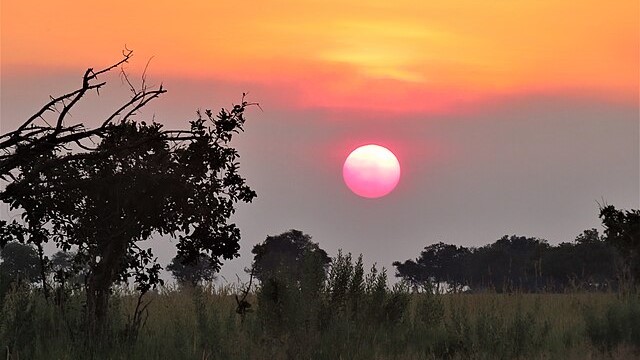In the early morning light, the Okavango Delta shimmers like a mirage across Botswana’s northwest. Papyrus reeds sway gently in the breeze, their reflections rippling across channels of water that wind between countless islands. This vast inland delta—spanning more than 15,000 square kilometers—forms one of the largest and most complex wetland systems on Earth, a rare oasis in the heart of southern Africa.
A UNESCO World Heritage Site, the delta supports an extraordinary concentration of wildlife. Elephants roam its floodplains in large herds, hippos gather in deep pools, and lions patrol the grassy edges. Overhead, carmine bee-eaters flash scarlet against the sky, while fish eagles circle above. The intricate mosaic of lagoons, channels, and seasonal floodplains sustains both predator and prey, making it one of the most biologically rich regions in Africa.
From above, the delta reveals itself as an elaborate tapestry of greens and blues. Scenic flights offer a bird’s-eye view of its shifting waterways, each season reshaping the landscape. On the ground, the pace slows. Travel often begins in a mokoro, the traditional dugout canoe steered quietly through narrow channels. The sound of the pole pushing against the sandy bottom blends with the rustle of reeds and the distant call of a kingfisher.
Along the banks, elephants wade deliberately through shallow water, ears fanning against the heat. Hippos surface with a snort before sinking beneath the lily-strewn surface. Guides—many raised in nearby villages—share knowledge of the delta’s delicate ecology and the cultural traditions tied to its waters. Their presence offers both orientation and a deeper understanding of the landscape’s rhythms.
Beyond the waterways lies Moremi Game Reserve, where open savannah meets woodland. Game drives and walking safaris here may reveal wild dogs coursing through the grass, leopards resting in acacia branches, and herds of antelope pausing to drink. In the dry season, wildlife converges around shrinking pools, bringing predators and prey into close proximity.
Night falls quickly in the delta, revealing an entirely different panorama. The absence of artificial light leaves the sky unblemished, constellations spilling across the horizon. The nocturnal chorus begins—frogs, nightjars, and distant hyenas—layered over the steady hush of water moving through reeds.
The Okavango Delta remains a place where water carves life into the Kalahari sands, sustaining both ancient ecosystems and human communities. Its beauty is not simply visual; it lies equally in the quiet, in the interdependence of species, and in the sense of scale that comes from standing at the edge of so much unspoiled wilderness.
Sources
- UNESCO World Heritage Centre. Okavango Delta. Retrieved 2025.
- National Geographic. “Okavango Delta: Africa’s Last Eden.” 2023.
- Botswana Tourism Organization. Okavango Delta Travel Guide. Accessed 2025.

